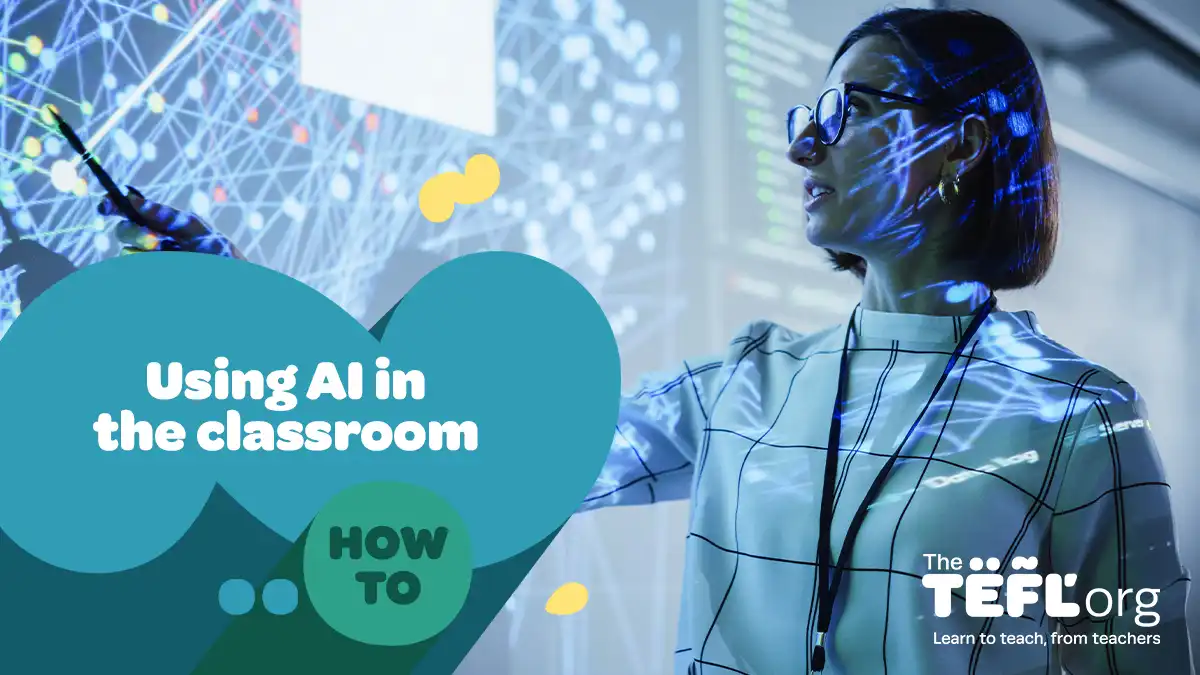- TEFL Courses
- New to TEFL New to TEFL
- Locations
- TEFL Jobs
- Teach Abroad Teach Abroad
- Teach English Abroad
- Teach English in Japan
- Teach English in South Korea
- Teach English in Spain
- Teach English in China
- TEFL Salaries Abroad
- Requirements for teaching abroad
- Teach English abroad without a degree
- How to find teaching jobs abroad without experience
- Can you teach English abroad as a non-native speaker?

- Teach Online
- About Us
- Blog
- Podcast

How to use AI in the TEFL classroom
For many, an exciting future lies in Artificial Intelligence. Perhaps just as many others, however, view the letters ‘AI’ as something like a dirty word. In the same way that AI is creating incredible digital inroads to revolutionise the world of work, it’s providing what many consider an existential threat to a number of industries.
However you look at it, you can’t argue it hasn’t grown rapidly of late. ChatGPT isn’t just a conversation starter in the office, it’s becoming an integral part of boardroom discussions. Competitors have arrived, including BardAI, Google’s answer to ChatGPT. Before long, other tech giants will also have their answer. It can seem scary, especially when there are as many voices heralding it as the future as there are warning against its rapid expansion .
At this point in time though, is it a scary existentialist threat, or is it something that teachers - especially TEFL teachers - can use in the classroom? From invigorating conversations (in English) to using the currently available tools for games and exercises, there might be something in all this AI that teachers should explore.How do you go about that? Let’s discuss using AI in the TEFL classroom.
Acknowledging AI
The chances are you will be dealing with students who have grown up online. They’re going to know about AI - there’s even a Snapchat AI bot - so pretending it doesn’t exist isn’t going to work.
Why will you have to acknowledge it? Well, it’s simple: you’re going to have to set parameters as a teacher. A cheeky student or two is going to try to use AI for homework, or for assignments, or at the very least to see if anyone - teacher or fellow student - is going to notice they’ve utilised AI for school work. Obviously, that’s not acceptable, and it’s essential to both be honest with your students about AI, and be clear that there are ways of detecting when it’s been used .
A student needs to know that they’re not going to effectively learn English just by using AI, they need proper teaching and to be engaging meaningfully with lessons and homework. However, being cognisant of this fast-developing technology, and even using it in the classroom, will inspire mutual trust around the subject of artificial intelligence.Pretending AI doesn’t exist, and not using it to your advantage as a teacher, won’t help. Using it to your advantage will have several positives: you can generate exciting conversations about ethics, give an example of essays created by AI platforms, and set tasks based on narratives surrounding AI.

AI Games
Now, obviously, your students will be curious about platforms like ChatGPT. So how do TEFL teachers “gamify” the experience, and create learning outcomes?
Visual learning is a great way to kick things off. Testing the creativity of your students with programmes like Dall-E or Midjourney , using English-language prompts to create surrealist pieces of art, is a fantastic way to bring discussions around AI to life.
Another way you can engage students is by asking them to use ChatGPT in English to write prompts and answer questions. This can be self-directed from a student’s point of view, for example, you can ask your pupils to perform presentations on a particular topic of interest, using information from AI to assist in information gathering. Or, you can set an essay question, allowing students to gather information from an AI programme.These exercises serve as good translation tasks, as well as self-directed study. Allowing students to be creative in their English learning can aid recall and, as studies have shown , can boost motivation and clarity of aims in learning.
Lesson plans
How can AI help teachers directly? Lesson planning, of course.
The future of lesson planning may be algorithmic. At its core, setting up lessons to aid learners of different proficiencies, or even different ages, can be extremely difficult. It can take years of teaching different kinds of classes to fully understand how to make your lesson plans work for everyone.
This is where AI can come in. Through prompts, a service like ChatGPT can help to generate specific plans tailored to your students. Nick Peachy’s “ A Teacher's Prompt Guide to ChatGPT aligned with 'What Works Best '” suggests the following prompt: "Create a
lesson plan for a class of students that covers [concept
being taught] and includes a variety of activities and assessments." This about covers it: through specificity and giving the AI enough to work with, you can find solutions to lesson-planning dilemmas.
Nobody is currently suggesting that teachers use this solely. What’s clear is that AI won’t get things perfectly, and you’ll have to edit and adjust what the technology gives you. Teachers who want to use this tech need to have the skills and knowledge to know when human correction is required.
Still, it’s certainly an interesting use of new technology and a useful way to address problem areas in lesson planning. What’s more, it can help in the organisational parts of teaching - knowing lesson plans can be generated intelligently is a real time-saver when work is building up.
The homework issue
We’ve already covered how AI can be used nefariously in terms of schoolwork, but it’s important to address what we’re going to refer to as “the homework issue”. Although you’ve set parameters and rules, it’s important to have systems in place to ensure a level of trust with your pupils, so that the likes of Bard and ChatGPT aren’t removing the element of challenge from translations and creative tasks.
Perhaps it’s best to move away from assignments involving long passages of text. To this end, presentations, group tasks and creative projects can utilise AI to aid proficiency. When long passages of text are the only option, be sure to remind pupils that AI-generated text can be picked up by detection programmes , and like AI, these programmes will only become more sophisticated in identifying plagiarism.
Furthermore, AI won’t generate perfect phrasing in foreign languages. Not yet. When Google Translate became more prominent, a common problem was that the text it generated wasn’t phrased properly, or it used synonyms or uncommon phrasing. This meant teachers could very easily identify when Google Translate had been used during homework.

The future
Perhaps there’s a future in which schools adapt fully to automation, and help to deliver personalised lesson plans to teachers, or indeed, students will have their own lessons devised for them. We simply can’t tell what the future will be with AI in education.
However, that time isn’t here. While the likes of Bard and ChatGPT can sound like a potential headache for teachers, the tools we have available right now can be a major help, rather than a hindrance in the TEFL classroom. While cynicism around the practical use of these programmes is healthy and entirely understandable, there are also opportunities to be had for TEFL teachers who adapt early.
At the moment, the best use of AI is in generating ideas. Ideas for games, challenges, homework tasks - it doesn’t hurt, nor make you “less” of a teacher, for generating ideas through highly intuitive software. As an organisational tool, it can be useful, especially in helping with workload prioritisation and, eventually, for coordinating your calendar.Right now, though? Don’t rely on it. Generally speaking, this technology is in its infancy, so don’t go throwing your ideas about teaching out the window. What you’ve learned in your TEFL course, advice from other teachers and your own experiences are far more valuable resources.
Interested in lesson planning and resources? The TEFL Org has you covered!













Leave a Comment
Your email address will not be published.
(0/1500 characters)
Quick Maths Test